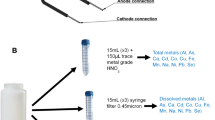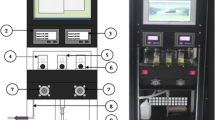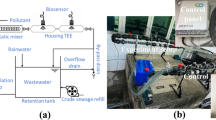Abstract
Elevated concentrations of heavy metals in water caused by mining activities create significant risks to the environment. Traditional biological methods used to assess heavy metal–related toxicity in aquatic environments are lengthy and labor intensive. Real-time biomonitoring approaches eliminate some of these limitations and provide a more accurate indication of toxicity. This study describes the performance of a flow-through and floating design microbial fuel cell (MFC) biosensors for real-time detection of copper (Cu) and other heavy metal–related toxicity in aquatic environments. Several biomonitoring tests were carried out using Cu and mining effluents as toxicants. The biosensors were able to detect, in real-time, Cu-related toxicity at concentrations as low as 35 - 40 μg L−1, as confirmed by a Daphnia assay. A comparison of the floating biosensor’s outputs with Daphnia magna survival rates showed a linear correlation with a coefficient of determination (R2) higher than 0.9. In addition, the flow-through biosensor was shown to be able to detect differences in the quality of two mining effluents with different compositions of heavy metals. Finally, the biosensor's real-time field performance was investigated in two aquatic environments in the Sudbury, Ontario region of Canada.







Similar content being viewed by others
References
Adekunle, A., Raghavan, V., & Tartakovsky, B. (2019a). A comparison of microbial fuel cell and microbial electrolysis cell biosensors for real-time environmental monitoring. Bioelectrochemistry, 126, 105–112.
Adekunle, A., Raghavan, V., & Tartakovsky, B. (2019b). On-line monitoring of heavy metals-related toxicity with a microbial fuel cell biosensor. Biosensors & Bioelectronics, 132, 382–390.
APHA, AWWA, WEF. (1995). Standard methods for the examination of water and wastewater (19th ed.). Washington, DC: American Public Health Association.
ASTM. (1988). American Society for Testing Materials- standard guide for conducting renewal life-cycle toxicity tests with Daphnia magna. Annual Book of ASTM Standards, 1104, 1–17.
Atienzar, F. A., Cheung, V. V., Jha, A. N., & Depledge, M. H. (2001). Fitness parameters and DNA effects are sensitive indicators of copper-induced toxicity in Daphnia magna. Toxicological Sciences, 59(2), 241–250.
Beauchemin, D. (2010) Inductively Coupled Plasma Mass Spectrometry. Analytical Chemistry, 82(12), 4786-4810
Chung, H., Ju, W. J., Jho, E. H., & Nam, K. (2016). Applicability of a submersible microbial fuel cell for Cr (VI) detection in water. Environmental Monitoring and Assessment, 188(11), 613.
Dávila, D., Esquivel, J., Sabate, N., & Mas, J. (2011). Silicon-based microfabricated microbial fuel cell toxicity sensor. Biosensors & Bioelectronics, 26(5), 2426–2430.
Di Lorenzo, M., Thomson, A. R., Schneider, K., Cameron, P. J., & Ieropoulos, I. (2014). A small-scale air-cathode microbial fuel cell for on-line monitoring of water quality. Biosensors & Bioelectronics, 62, 182–188.
Dubé, M. G., MacLatchy, D. L., Hruska, K. A., & Glozier, N. E. (2006). Assessing the responses of creek chub (Semotilus atromaculatus) and pearl dace (Semotilus margarita) to metal mine effluents using in situ artificial streams in Sudbury, Ontario, Canada. Environmental Toxicology and Chemistry, 25(1), 18–28.
Erickson, R. J., Benoit, D. A., Mattson, V. R., Leonard, E. N., & Nelson, H. P. (1996). The effects of water chemistry on the toxicity of copper to fathead minnows. Environmental Toxicology and Chemistry, 15(2), 181–193.
Farré, M., & Barceló, D. (2003). Toxicity testing of wastewater and sewage sludge by biosensors, bioassays and chemical analysis. TrAC Trends in Analytical Chemistry, 22(5), 299–310.
Ferguson, J. E. (1990). The heavy elements: chemistry, environmental impact and health effects, (pp 412). New York: Pergamon Press.
Grondin, F., Perrier, M., & Tartakovsky, B. (2012). Microbial fuel cell operation with intermittent connection of the electrical load. Journal of Power Sources, 208, 18–23.
He, Z., Minteer, S. D., & Angenent, L. T. (2005). Electricity generation from artificial wastewater using an upflow microbial fuel cell. Environmental Science & Technology, 39(14), 5262–5267.
Heijne, A. T., Liu, F., Weijden, R. V. D., Weijma, J., Buisman, C. J. N., & Hamelers, H. V. M. (2010). Copper recovery combined with electricity production in a microbial fuel cell. Environmental Science & Technology, 44(11), 4376–4381.
Jiang, Y., Liang, P., Zhang, C., Bian, Y., Yang, X., Huang, X., & Girguis, P. R. (2015). Enhancing the response of microbial fuel cell based toxicity sensors to Cu(II) with the applying of flow-through electrodes and controlled anode potentials. Bioresource Technology, 190, 367–372.
Kim, M., Sik Hyun, M., Gadd, G. M., & Joo Kim, H. (2007). A novel biomonitoring system using microbial fuel cells. [Article]. Journal of Environmental Monitoring, 9(12), 1323–1328.
Logan, B. E., Hamelers, B., Rozendal, R., Schröder, U., Keller, J., Freguia, S., Aelterman, P., Verstraete, W., & Rabaey, K. (2006). Microbial Fuel cells: methodology and technology†. Environmental Science & Technology, 40(17), 5181–5192.
MacDonald, D., Smorong, D., Levy, D., Swain, L., Caux, P., & Kemper, J. (2002). Guidance on the site-specific application of water quality guidelines in Canada: procedures for deriving numerical water quality objectives. Report prepared for the Canadian Council of Ministers of the Environment and Environment Canada.
Northey, S., Haque, N., & Mudd, G. (2013). Using sustainability reporting to assess the environmental footprint of copper mining. Journal of Cleaner Production, 40, 118–128.
OECD (1984). Organization for Economic Cooperation Development- Daphnia sp., acute immobilisation test and reproduction test. 202 OECD Guideline for Testing of Chemicals.
Oh, S. E., & Logan, B. E. (2007). Voltage reversal during microbial fuel cell stack operation. Journal of Power Sources, 167(1), 11–17.
Patil, S., Harnisch, F., & Schröder, U. (2010). Toxicity response of electroactive microbial biofilms-a decisive feature for potential biosensor and power source applications. [Article]. ChemPhysChem, 11(13), 2834–2837.
Peplow, D. (1999). Environmental impacts of mining in eastern Washington. University of Washington Water Center.
Pham, H. T., Boon, N., Aelterman, P., Clauwaert, P., De Schamphelaire, L., Van Oostveldt, P., et al. (2008). High shear enrichment improves the performance of the anodophilic microbial consortium in a microbial fuel cell. Microbial Biotechnology, 1(6), 487–496.
Reemtsma, T. (2001). Prospects of toxicity-directed wastewater analysis. Analytica Chimica Acta, 426(2), 279–287.
Rozendal, R. A., Jeremiasse, A. W., Hamelers, H. V., & Buisman, C. J. (2007). Hydrogen production with a microbial biocathode. Environmental Science & Technology, 42(2), 629–634.
Shen, Y., Wang, M., Chang, I. S., & Ng, H. Y. (2013). Effect of shear rate on the response of microbial fuel cell toxicity sensor to Cu(II). Bioresource Technology, 136(Supplement C), 707–710.
Tao, H.-C., Liang, M., Li, W., Zhang, L.-J., Ni, J.-R., & Wu, W.-M. (2011). Removal of copper from aqueous solution by electrodeposition in cathode chamber of microbial fuel cell. Journal of Hazardous Materials, 189(1), 186–192.
Waalkes, M. P., Coogan, T. P., & Barter, R. A. (1992). Toxicological principles of metal carcinogenesis with special emphasis on cadmium. Critical Reviews in Toxicology, 22(3-4), 175–201.
Weber, L. P., Dubé, M. G., Rickwood, C. J., Driedger, K., Portt, C., Brereton, C., & Janz, D. M. (2008). Effects of multiple effluents on resident fish from Junction Creek, Sudbury, Ontario. Ecotoxicology and Environmental Safety, 70(3), 433–445.
Yu, D., Bai, L., Zhai, J., Wang, Y., & Dong, S. (2017). Toxicity detection in water containing heavy metal ions with a self-powered microbial fuel cell-based biosensor. Talanta, 168, 210–216.
Zhu, X., & Logan, B. E. (2014). Copper anode corrosion affects power generation in microbial fuel cells. Journal of Chemical Technology and Biotechnology, 89(3), 471–474.
Author information
Authors and Affiliations
Corresponding author
Additional information
Publisher’s note
Springer Nature remains neutral with regard to jurisdictional claims in published maps and institutional affiliations.
Rights and permissions
About this article
Cite this article
Adekunle, A., Rickwood, C. & Tartakovsky, B. Online monitoring of heavy metal–related toxicity using flow-through and floating microbial fuel cell biosensors. Environ Monit Assess 192, 52 (2020). https://doi.org/10.1007/s10661-019-7850-0
Received:
Accepted:
Published:
DOI: https://doi.org/10.1007/s10661-019-7850-0




